Congress of the Philippines
The Congress of the Philippines (Filipino: Kongreso ng Pilipinas) is the legislature of the national government of the Philippines. It is bicameral, composed of a lower body, the House of Representatives,[3] although colloquially the term "Congress" commonly refers to just the latter,[lower-alpha 2] and an upper body, the Senate. The House of Representatives meets in the Batasang Pambansa in Quezon City while the Senate meets in the GSIS Building in Pasay.
Congress of the Philippines Kongreso ng Pilipinas | |
|---|---|
| 19th Congress of the Philippines | |
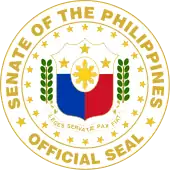 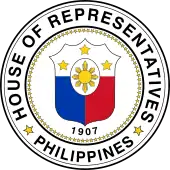 Seals of the Senate (left) and of the House of Representatives (right) | |
| Type | |
| Type | |
| Houses | Senate House of Representatives |
| History | |
| Founded | June 9, 1945 (77 years ago) |
| Preceded by | National Assembly of the Philippines |
New session started | July 25, 2022 |
| Leadership | |
President of the Senate | |
Speaker of the House of Representatives | |
| Structure | |
| Seats | 340 (see list) 24 senators 316 representatives |
 | |
Senate political groups |
|
 | |
House of Representatives political groups |
|
Joint committees | Joint committees are chaired by senators |
| Authority | Article VI of the Constitution of the Philippines |
| Elections | |
| Multiple non-transferable vote | |
| Parallel voting (Party-list proportional representation and first-past-the-post) | |
Senate last election | May 9, 2022 |
House of Representatives last election | May 9, 2022 |
Senate next election | May 12, 2025 |
House of Representatives next election | May 12, 2025 |
| Meeting place | |
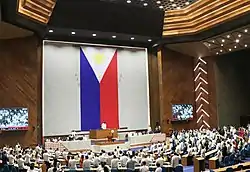 | |
| Joint sessions are usually held at the Batasang Pambansa Complex, Quezon City | |
| Website | |
| Senate of the Philippines House of Representatives of the Philippines | |
The Senate is composed of 24 senators[4] half of which are elected every three years. Each senator, therefore, serves a total of six years. The senators are elected at-large and do not represent any geographical district.
In the current 19th Congress, there are 316 seats in the House of Representatives. The Constitution states that the House "shall be composed of not more than 250 members, unless otherwise fixed by law," and that at least 20% of it shall be sectoral representatives. There are two types of congressmen: the district and party-list representatives. At the time of the ratification of the constitution, there were 200 districts, leaving 50 seats for party-list representatives.
The district congressmen represent a particular congressional district of the country. All provinces in the country are composed of at least one congressional district. Several cities also have their own congressional districts, with some having two or more representatives.[3] From 200 districts in 1987, the number of districts have increased to 243. Every new Congress has seen an increase in the number of districts.
The party-list congressmen represent the minority sectors of the population. This enables these minority groups to be represented in the Congress, when they would otherwise not be represented properly through district representation. Party-list representatives represent labor unions, rights groups, and other organizations.[3] With the increase of districts also means that the seats for party-list representatives increase as well, as the 1:4 ratio has to be respected.
The Constitution provides that Congress shall convene for its regular session every year beginning on the 4th Monday of July. A regular session can last until thirty days before the opening of its next regular session in the succeeding year. The president may, however, call special sessions which are usually held between regular legislative sessions to handle emergencies or urgent matters.[3]
History
Spanish era
During the Spanish colonization of the Philippines, municipal governments, or Cabildos were established. One such example was the Cabildo in Manila, established in 1571.[5]
When the Philippines was under colonial rule as part of the Spanish East Indies, the colony was not given representation to the Spanish Cortes. It was only in 1809 where the colony was made an integral part of Spain and was given representation in the Cortes. While colonies such as the Philippines were selecting its delegates, substitutes were named so that the Cortes can convene. The substitutes, and first delegates for the Philippines were Pedro Pérez de Tagle and José Manuel Couto. Both had no connections to the colony.[6]
By July 1810, Governor General Manuel González de Aguilar received the instruction to hold an election. As only the Manila Municipal Council qualified to elect a representative, it was tasked to select a delegate. Three of its representatives, the governor-general and the Archbishop of Manila selected Ventura de los Reyes as Manila's delegate to the Cortes. De los Reyes arrived in Cadiz in December 1811.[6]
However, with Napoleon I's defeat at the Battle of Waterloo, his brother Joseph Bonaparte was removed from the Spanish throne, and the Cádiz Constitution was replaced by the Cortes on May 24, 1816, with a more conservative constitution that removed Philippine representation on the Cortes, among other things. Restoration of Philippine representation to the Cortes was one of the grievances by the Ilustrados, the educated class during the late 19th century.[4]
Revolutionary era
The Illustrados' campaign transformed into the Philippine Revolution that aimed to overthrow Spanish rule. Proclaiming independence on June 12, 1898, President Emilio Aguinaldo then ordered the convening of a revolutionary congress at Malolos. The Malolos Congress, among other things, approved the Malolos Constitution. With the approval of the Treaty of Paris, the Spanish ceded the Philippines to the United States. The revolutionaries, attempting to prevent American conquest, launched the Philippine–American War, but were defeated when Aguinaldo was captured in 1901.[4]
American era
When the Philippines was under American colonial rule, the legislative body was the Philippine Commission which existed from 1900 to 1907. The President of the United States appointed the members of the Philippine Commission. Furthermore, two Filipinos served as Resident Commissioners to the House of Representatives of the United States from 1907 to 1935, then only one from 1935 to 1946. The Resident Commissioners had a voice in the House, but did not have voting rights.[4]
The Philippine Bill of 1902 mandated the creation of a bicameral or a two-chamber Philippine Legislature with the Philippine Commission as the Upper House and the Philippine Assembly as the Lower House. This bicameral legislature was inaugurated in 1907. Through the leadership of then Speaker Sergio Osmeña and then-Floor Leader Manuel L. Quezon, the Rules of the 59th United States Congress were substantially adopted as the Rules of the Philippine Legislature.[4]
In 1916, the Jones Law changed the legislative system. The Philippine Commission was abolished, and a new bicameral Philippine Legislature consisting of a House of Representatives and a Senate was established.[4]
Commonwealth and Second Republic era
The legislative system was changed again in 1935. The 1935 Constitution, aside from instituting the Commonwealth which gave the Filipinos more role in government, established a unicameral National Assembly. But in 1940, through an amendment to the 1935 Constitution, a bicameral Congress of the Philippines consisting of a House of Representatives and a Senate was created. Those elected in 1941 would not serve until 1945, as World War II erupted. The invading Japanese set up the Second Philippine Republic and convened its own National Assembly. With the Japanese defeat in 1945, the Commonwealth and its Congress was restored. The same setup continued until the Americans granted independence on July 4, 1946.[4]
Independent era
Upon the inauguration of the Republic of the Philippines on July 4, 1946, Republic Act No. 6 was enacted providing that on the date of the proclamation of the Republic of the Philippines, the existing Congress would be known as the First Congress of the Republic. Successive Congresses were elected until President Ferdinand Marcos declared martial law on September 23, 1972. Marcos then ruled by decree.[4]
As early as 1970, Marcos had convened a constitutional convention to revise the 1935 constitution; in 1973, the Constitution was approved. It abolished the bicameral Congress and created a unicameral National Assembly, which would ultimately be known as the Batasang Pambansa in a semi-presidential system of government. The batasan elected a prime minister. The Batasang Pambansa first convened in 1978. [4]
Marcos was overthrown after the 1986 People Power Revolution; President Corazon Aquino then ruled by decree. Later that year she appointed a constitutional commission that drafted a new constitution. The Constitution was approved in a plebiscite the next year; it restored the presidential system of government together with a bicameral Congress of the Philippines. It first convened in 1987.[4]
Seat
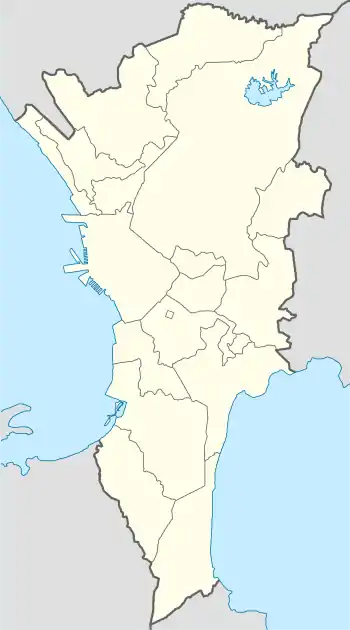
The two houses of Congress meet at different places in Metro Manila, the seat of government: the Senate meets at the GSIS Building, the main office of the Government Service Insurance System (GSIS) at Pasay, while the House of Representatives sits at the Batasang Pambansa Complex in Quezon City. The two are around 25 kilometers (16 mi) apart.
 Barasoain Church
Barasoain Church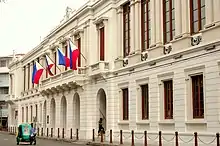 Ayuntamiento de Manila
Ayuntamiento de Manila Old Legislative Building
Old Legislative Building
The Barasoain Church in Malolos, Bulacan served as a meeting place of unicameral congress of the First Philippine Republic.
After the Americans defeated the First Republic, the US-instituted Philippine Legislature convened at the Ayuntamiento in Intramuros, Manila from 1907 to 1926, when it transferred to the Legislative Building just outside Intramuros. In the Legislative Building, the Senate occupied the upper floors while the House of Representatives used the lower floors.
With the Legislative Building destroyed during the Battle of Manila of 1945, the Commonwealth Congress convened at the Old Japanese Schoolhouse at Sampaloc. Congress met at the school auditorium, with the Senate convening on evenings and the House of Representatives meeting every morning. The Senate subsequently moved to the Manila City Hall, with the House staying in the schoolhouse. The two chambers of Congress returned to the reconstructed Legislative Building, now the Congress Building in 1950. In 1973, when President Marcos ruled by decree, Congress was padlocked. Marcos built a new seat of a unicameral parliament at Quezon City, which would eventually be the Batasang Pambansa Complex. The parliament that will eventually be named as the Batasang Pambansa (National Legislature), first met at the Batasang Pambansa Complex in 1978.
With the overthrow of Marcos after the People Power Revolution, the bicameral Congress was restored. The House of Representatives inherited the Batasang Pambansa Complex, while the Senate returned to the Congress Building. In May 1997, the Senate moved to the newly constructed building owned by the GSIS on land reclaimed from Manila Bay at Pasay; the Congress Building was eventually transformed into the National Museum of Fine Arts. The Senate will eventually move into a new building that they would own in Fort Bonifacio, Taguig.
Powers
_%252C_Republic_of_the_Philippines.svg.png.webp)
_%252C_Congress_of_the_Philippines.svg.png.webp)
The powers of the Congress of the Philippines may be classified as:
| General Legislative
It consists of the enactment of laws intended as a rule of conduct to govern the relation between individuals (i.e., civil laws, commercial laws, etc.) or between individuals and the state (i.e., criminal law, political law, etc.)[4] |
Implied Powers
It is essential to the effective exercise of other powers expressly granted to the assembly. |
Inherent Powers
These are the powers which although not expressly given are nevertheless exercised by the Congress as they are necessary for its existence such as:
|
Specific Legislative
It has reference to powers which the Constitution expressly and specifically directs to perform or execute. Powers enjoyed by the Congress classifiable under this category are:
|
| Executive
Powers of the Congress that are executive in nature are:
|
Supervisory
The Congress of the Philippines exercises considerable control and supervision over the administrative branch - e.g.:
|
Electoral
Considered as electoral power of the Congress of the Philippines are the Congress' power to:
|
Judicial
Constitutionally, each house has judicial powers:
|
| Miscellaneous
The other powers of Congress mandated by the Constitution are as follows:
| |||
Lawmaking
Politics of the Philippines |
|---|
 |
|
- Preparation of the bill
- The Member or the Bill Drafting Division of the Reference and Research Bureau prepares and drafts the bill upon the Member's request.
- First reading
- The bill is filed with the Bills and Index Service and the same is numbered and reproduced.
- Three days after its filing, the same is included in the Order of Business for First Reading.
- On First Reading, the Secretary General reads the title and number of the bill. The Speaker refers the bill to the appropriate Committee/s.
- Committee consideration / action
- The Committee where the bill was referred to evaluates it to determine the necessity of conducting public hearings.
- If the Committee finds it necessary to conduct public hearings, it schedules the time thereof, issues public notices and invites resource persons from the public and private sectors, the academe, and experts on the proposed legislation.
- If the Committee determines that public hearing is not needed, it schedules the bill for Committee discussion/s.
- Based on the result of the public hearings or Committee discussions, the Committee may introduce amendments, consolidate bills on the same subject matter, or propose a substitute bill. It then prepares the corresponding committee report.
- The Committee approves the Committee Report and formally transmits the same to the Plenary Affairs Bureau.
- Second reading
- The Committee Report is registered and numbered by the Bills and Index Service. It is included in the Order of Business and referred to the Committee on Rules.
- The Committee on Rules schedules the bill for consideration on Second Reading.
- On Second Reading, the Secretary General reads the number, title and text of the bill and the following takes place:
- Period of Sponsorship and Debate
- Period of Amendments
- Voting, which may be by
- viva voce
- count by tellers
- division of the House
- nominal voting
- Third reading
- The amendments, if any, are engrossed and printed copies of the bill are reproduced for Third Reading.
- The engrossed bill is included in the Calendar of Bills for Third Reading and copies of the same are distributed to all the Members three days before its Third Reading.
- On Third Reading, the Secretary General reads only the number and title of the bill.
- A roll call or nominal voting is called and a Member, if he desires, is given three minutes to explain his vote. No amendment on the bill is allowed at this stage.
- The bill is approved by an affirmative vote of a majority of the Members present.
- If the bill is disapproved, the same is transmitted to the Archives.
- Transmittal of the approved bill to the Senate
- The approved bill is transmitted to the Senate for its concurrence.
- Senate action on approved bill of the House
- The bill undergoes the same legislative process in the Senate.
- Conference committee
- A Conference Committee is constituted and is composed of Members from each House of Congress to settle, reconcile or thresh out differences or disagreements on any provision of the bill.
- The conferees are not limited to reconciling the differences in the bill but may introduce new provisions germane to the subject matter or may report out an entirely new bill on the subject.
- The Conference Committee prepares a report to be signed by all the conferees and the chairman.
- The Conference Committee Report is submitted for consideration/approval of both Houses. No amendment is allowed.
- Transmittal of the bill to the President
- Copies of the bill, signed by the Senate President and the Speaker of the House of Representatives and certified by both the Secretary of the Senate and the Secretary General of the House, are transmitted to the President.
- Presidential action on the bill
- If the bill is approved by the President, it is assigned an RA number and transmitted to the House where it originated.
- Action on approved bill
- The bill is reproduced and copies are sent to the Official Gazette Office for publication and distribution to the implementing agencies. It is then included in the annual compilation of Acts and Resolutions.
- Action on vetoed bill
- The message is included in the Order of Business. If the Congress decides to override the veto, the House and the Senate shall proceed separately to reconsider the bill or the vetoed items of the bill. If the bill or its vetoed items is passed by a vote of two-thirds of the Members of each House, such bill or items shall become a law.
Composition
In the diagrams below, Congress is divided in blocs, with the colors referring to the political party of the person leading that bloc. The blocs are determined by the vote of the member in speakership or Senate presidential elections.
The Senate is composed of the winners of the 2016 and 2019 Senate elections. The House of Representatives is composed of the winners of the 2019 House of Representatives elections. In both chambers, the majority bloc is composed of members generally supportive of the presidency of Rodrigo Duterte, while the minority blocs are those opposed. In the House of Representatives, there is an independent minority bloc, and 4 vacant seats.
In both chambers, membership in committees is determined by the size of the bloc; only members of the majority and minority blocs are given committee memberships. In the Philippines, political parties are liquid, and it is not uncommon to see partymates see themselves on different blocs.
Leadership
Each chamber is headed by a presiding officer, both elected from their respective membership; in the Senate, it is the Senate President, while in the House of Representatives, it is the Speaker. The Senate also has a Senate president pro tempore, and the House of Representatives has deputy speakers. Each chamber has its own floor leaders.
Voting requirements
The vote requirements in the Congress of the Philippines are as follows:
| Requirement | Senate | House of Representatives | Joint session | All members |
|---|---|---|---|---|
| One-fifth |
|
N/A | N/A | |
| One-third | N/A |
|
N/A | N/A |
| Majority (50% +1 member) |
|
|
|
|
| ||||
| Two-thirds |
|
|
| |
|
N/A | |||
| Three-fourths | N/A | N/A | N/A |
|
In most cases, such as the approval of bills, only a majority of members present is needed; on some cases such as the election of presiding officers, a majority of all members, including vacant seats, is needed.
Sessions
A new session of Congress starts after every House of Representatives election. During the operation of the 1935 constitution as amended in 1940, mid-term elections in the Senate cause its membership to be changed mid-session. From 1945 to 1972, there were two commonwealth congresses and seven congresses of the republic, with the 2nd Commonwealth Congress becoming the 1st Congress of the Republic. During the usage of the 1973 constitution, the Batasang Pambansa was the legislature, with it having two elections. Starting in the 1987 constitution, each Senate election was synchronized with the House elections, with the first congress under that constitution being counted as the "8th Congress", picking up from the last congress of the 1935 constitution.
Per historical era
| In operation | Authority | Regime | Legislature | Type | Upper house | Lower house |
|---|---|---|---|---|---|---|
| 1898–99 | Malolos Constitution | Malolos Congress | Unicameral | Malolos Congress | ||
| War powers authority of the President of the United States | Martial law; military governor ruled by decree | |||||
| 1900–1902 | Malolos Constitution | Malolos Congress | Unicameral | Malolos Congress | ||
| Appointment by the President of the United States | Taft Commission | Unicameral | Philippine Commission | |||
| 1902–1907 | Philippine Organic Act | Philippine Commission | Unicameral | |||
| 1907–1916 | Philippine Legislature | Bicameral | Philippine Commission | Philippine Assembly | ||
| 1916–1935 | Philippine Autonomy Act | Bicameral | Senate | House of Representatives | ||
| 1935–1941 | 1935 Constitution | National Assembly | Unicameral | National Assembly | ||
| 1942–43 | War powers authority of the Emperor of Japan | Martial law; governor-general ruled by decree | ||||
| 1943–44 | 1943 Constitution | National Assembly | Unicameral | National Assembly | ||
| 1945–46 | Amendments to the 1935 Constitution | Congress (Commonwealth) | Bicameral | Senate | House of Representatives | |
| 1946–1973 | Congress | Bicameral | ||||
| 1973–1976 | 1973 Constitution | Martial law; president ruled by decree | ||||
| 1976–1978 (never convened) |
Batasang Bayan | Unicameral | National Assembly | |||
| 1978–1986 | Amendments to the 1973 Constitution | Batasang Pambansa | Unicameral | Batasang Pambansa | ||
| 1986–1987 | President ruled by decree | |||||
| 1987–present | 1987 Constitution | Congress | Bicameral | Senate | House of Representatives | |
List of Congresses
| Election | Congress | Senate election results | House of Representatives elections results | ||
|---|---|---|---|---|---|
| Pre-1941 | See Philippine Legislature and National Assembly of the Philippines | ||||
| 1941 | 1st Commonwealth Congress |  |
24 Nacionalista |  |
95 Nacionalista 3 independent |
| 1946 | 2nd Commonwealth Congress |  |
9 Nacionalista (Liberal wing) 6 Nacionalista 1 Popular Front |
 |
49 Nacionalista (Liberal wing) 35 Nacionalista 6 Democratic Alliance 3 others |
| 1st Congress | |||||
| 1947 |  |
6 Liberal 2 Nacionalista | |||
| 1949 | 2nd Congress |  |
8 Liberal |  |
60 Liberal 33 Nacionalista 7 others |
| 1951 |  |
8 Nacionalista | |||
| 1953 | 3rd Congress |  |
5 Nacionalista 2 Democratic 1 Citizens' |
 |
59 Nacionalista 31 Liberal 11 Democratic 1 independent |
| 1955 |  |
9 Nacionalista | |||
| 1957 | 4th Congress |  |
6 Nacionalista 2 Liberal |
 |
82 Nacionalista 19 Liberal 1 NCP |
| 1959 |  |
5 Nacionalista 2 Liberal 1 NCP | |||
| 1961 | 5th Congress |  |
4 Liberal 2 Nacionalista 2 Progressive |
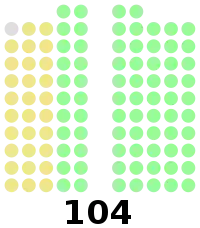 |
74 Nacionalista 29 Liberal 1 independent |
| 1963 |  |
4 Liberal 4 Nacionalista | |||
| 1965 | 6th Congress |  |
5 Nacionalista 2 Liberal 1 NCP |
 |
61 Liberal 38 Nacionalista 5 others |
| 1967 |  |
6 Nacionalista 1 Liberal 1 independent | |||
| 1969 | 7th Congress |  |
6 Nacionalista 2 Liberal |
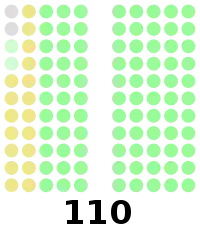 |
88 Nacionalista 18 Liberal 4 others |
| 1971 |  |
5 Liberal 3 Nacionalista | |||
| 1978, 1984 | See Batasang Pambansa | ||||
| 1987 | 8th Congress |  22 Majority–1 Minority
|
22 LABAN 2 GAD |
 |
43 PDP–Laban 24 Lakas ng Bansa 19 UNIDO 16 Liberal 11 KBL 55 coalitions 32 others 14 appointed sectoral seats |
| 1992 | 9th Congress |  23 Majority–1 Minority
|
16 LDP 5 NPC 2 Lakas 1 Liberal |
 |
86 LDP 41 Lakas 30 NPC 11 LP-PDP 32 others 16 appointed sectoral seats |
| 1995 | 10th Congress | 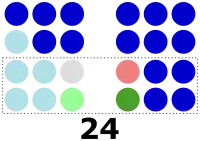 22 Majority–1 Minority
|
4 Lakas 4 LDP 1 Nacionalista 1 NPC 1 PRP 1 independent |
 160 Majority–22 Minority
|
157 pro-administration coalition 26 opposition coalition 12 hybrid coalitions 9 others 16 appointed sectoral seats |
| 1998 | 11th Congress |  22 Majority–1 Minority
|
5 Lakas 4 LDP 1 NPC 1 PMP 1 PDP–Laban |
 |
111 Lakas 55 LAMMP 15 Liberal 25 others 14 party-lists |
| 2001 | 12th Congress |  13 Majority–11 Minority
|
3 Lakas 2 LDP 1 Liberal 1 PDP–Laban 6 independent |
 185 Majority–17 Minority
|
73 Lakas 40 NPC 21 LDP 19 Liberal 52 others 17 party-lists |
| 2004 | 13th Congress |  13 Majority–10 Minority
|
5 KNP 4 Lakas 2 Liberal 1 PRP |
 193 Majority–28 Minority
|
92 Lakas 53 NPC 29 Liberal 15 LDP 20 others 28 party-lists |
| 2007 | 14th Congress |  15 Majority–7 Minority
|
2 Liberal 2 Nacionalista 2 NPC 2 UNO 1 KAMPI 1 LDP 1 PDP–Laban 1 independent |
 193 Majority–1 Minority
|
89 Lakas 44 KAMPI 28 NPC 23 Liberal 11 Nacionalista 23 others 53 party-lists |
| 2010 | 15th Congress |  17 Majority–3 Minority
|
3 Liberal 2 Lakas–Kampi 2 Nacionalista 2 PMP 1 NPC 1 PRP 1 independent |
 227 Majority–29 Minority
|
106 Lakas–Kampi 47 Liberal 29 NPC 25 Nacionalista 22 others 57 party-lists |
| 2013 | 16th Congress |  17 Majority–6 Minority
|
3 Nacionalista 3 UNA 1 LDP 1 Liberal 1 NPC 1 PDP–Laban |
 244 Majority–35 Minority
|
109 Liberal 42 NPC 24 NUP 18 Nacionalista 14 Lakas 27 others 59 party-lists |
| 2016 | 17th Congress |  20 Majority–3 Minority
|
5 Liberal 2 NPC 1 Akbayan 1 UNA 3 independent |
 252 Majority–36 Minority
|
115 Liberal 42 NPC 24 Nacionalista 23 NUP 11 UNA 23 others 59 party-lists |
| 2019 | 18th Congress |  20 Majority–4 Minority
|
4 PDP–Laban 3 Nacionalista 1 Lakas 1 LDP 1 NPC 1 UNA 1 independent |
 266 Majority–28 Minority
|
82 PDP–Laban 42 Nacionalista 37 NPC 23 NUP 18 Liberal 12 Lakas 27 others 61 party-lists |
| 2022 | 19th Congress |  20 Maj–2 Min–2 Ind
|
4 NPC 1 PDP-Laban 1 Nacionalista 1 Akbayan 1 PMP 4 independent |
 282 Majority–5 others
|
66 PDP–Laban 36 Nacionalista 35 NPC 33 NUP 26 Lakas 10 Liberal 47 others 62 party-lists |
Latest elections
Senate
In the Philippines, the most common way to illustrate the result in a Senate election is via a tally of candidates in descending order of votes. The twelve candidates with the highest number of votes are elected.
| # | Candidate | Coalition | Party | Votes | % | |
|---|---|---|---|---|---|---|
| 1. | Robin Padilla | Tuloy na Pagbabago, UniTeam[lower-alpha 3] | PDP–Laban | 27,027,235 | 48.18% | |
| 2. | Loren Legarda | UniTeam[lower-alpha 3], Lacson–Sotto slate[lower-alpha 4], MP3[lower-alpha 5], Tuloy na Pagbabago[lower-alpha 6] | NPC | 24,367,564 | 43.44% | |
| 3. | Raffy Tulfo | MP3[lower-alpha 5], Lacson–Sotto slate[lower-alpha 4] | Independent | 23,488,450 | 41.87% | |
| 4. | Win Gatchalian | UniTeam | NPC | 20,678,804 | 36.86% | |
| 5. | Francis Escudero | Lacson–Sotto slate[lower-alpha 4], MP3[lower-alpha 5], TRoPa[lower-alpha 7] | NPC | 20,320,069 | 36.22% | |
| 6. | Mark Villar | UniTeam, Tuloy na Pagbabago[lower-alpha 6] | Nacionalista | 19,563,262 | 34.88% | |
| 7. | Alan Peter Cayetano | Independent | 19,359,758 | 34.51% | ||
| 8. | Juan Miguel Zubiri | UniTeam, MP3[lower-alpha 5] | Independent | 18,931,207 | 33.75% | |
| 9. | Joel Villanueva | Lacson–Sotto slate[lower-alpha 4], MP3[lower-alpha 5], TRoPa[lower-alpha 7] | Independent | 18,539,537 | 33.05% | |
| 10. | JV Ejercito | Lacson–Sotto slate, MP3[lower-alpha 5] | NPC | 15,901,891 | 28.35% | |
| 11. | Risa Hontiveros | TRoPa, LEAD[lower-alpha 8] | Akbayan | 15,470,005 | 27.58% | |
| 12. | Jinggoy Estrada | UniTeam | PMP | 15,174,288 | 27.05% | |
| 13. | Jejomar Binay | MP3[lower-alpha 5], Lacson–Sotto slate[lower-alpha 4], TRoPa[lower-alpha 7] | UNA | 13,348,887 | 23.80% | |
| 14. | Herbert Bautista | UniTeam | NPC | 13,206,704 | 23.54% | |
| 15. | Gilbert Teodoro | UniTeam, Tuloy na Pagbabago[lower-alpha 6] | PRP | 12,827,577 | 22.87% | |
| 16. | Guillermo Eleazar | Lacson–Sotto slate | Reporma | 11,360,526 | 20.27% | |
| 17. | Harry Roque | UniTeam, Tuloy na Pagbabago[lower-alpha 6] | PRP | 11,285,713 | 20.14% | |
| 18. | Gregorio Honasan | Lacson–Sotto slate[lower-alpha 4], UniTeam[lower-alpha 3] | Independent | 10,668,886 | 19.04% | |
| 19. | Chel Diokno | TRoPa, LEAD[lower-alpha 8] | KANP | 10,020,008 | 17.88% | |
| 20. | Larry Gadon | UniTeam | KBL | 9,712,118 | 17.33% | |
| 21. | Antonio Trillanes | TRoPa | Liberal | 8,653,717 | 15.44% | |
| 22. | Dick Gordon | Lacson–Sotto slate[lower-alpha 4], MP3[lower-alpha 5], TRoPa[lower-alpha 7] | Bagumbayan | 8,427,820 | 15.04% | |
| 23. | Leila de Lima | TRoPa, LEAD[lower-alpha 8] | Liberal | 7,305,153 | 13.04% | |
| 24. | Neri Colmenares | Makabayan, LEAD[lower-alpha 8], MP3[lower-alpha 5] | Makabayan | 6,108,365 | 10.90% | |
| 25. | Alex Lacson | TRoPa | Ang Kapatiran | 5,499,733 | 9.81% | |
| 26. | Salvador Panelo | Tuloy na Pagbabago | PDP–Laban | 4,916,875 | 8.77% | |
| 27. | Francis Leo Marcos | Independent | 4,548,568 | 8.12% | ||
| 28. | Teddy Baguilat | LEAD[lower-alpha 8], TRoPa | Liberal | 4,284,752 | 7.65% | |
| 29. | Monsour del Rosario | Reporma | Reporma | 3,824,557 | 6.82% | |
| 30. | Carl Balita | Aksyon | Aksyon | 3,771,019 | 6.73% | |
| 31. | Tuloy na Pagbabago, UniTeam[lower-alpha 3] | PDP–Laban | 3,599,053 | 6.42% | ||
| 32. | Emmanuel Piñol | Lacson–Sotto slate | NPC | 3,570,287 | 6.37% | |
| 33. | Minguita Padilla | Lacson–Sotto slate | Reporma | 3,567,523 | 6.37% | |
| 34. | Luke Espiritu | LEAD | PLM | 3,480,211 | 6.21% | |
| 35. | Astra Pimentel-Naik | PDP–Laban | PDP–Laban | 3,002,907 | 5.36% | |
| 36. | Sonny Matula | TRoPa, LEAD[lower-alpha 8] | Independent | 2,698,368 | 4.81% | |
| 37. | Greco Belgica | Tuloy na Pagbabago | PDDS | 2,362,101 | 4.21% | |
| 38. | Jopet Sison | Aksyon | Aksyon | 2,223,959 | 3.96% | |
| 39. | Samira Gutoc | Aksyon, LEAD[lower-alpha 8] | Aksyon | 2,225,400 | 3.97% | |
| 40. | Carmen Zubiaga | Independent | 1,771,078 | 3.16% | ||
| 41. | Silvestre Bello Jr. | PDP–Laban | PDP–Laban | 1,744,355 | 3.11% | |
| 42. | Elmer Labog | Makabayan, LEAD[lower-alpha 8], MP3[lower-alpha 5] | Makabayan | 1,582,623 | 2.82% | |
| 43. | Rey Langit | Tuloy na Pagbabago | PDP–Laban | 1,369,680 | 2.44% | |
| 44. | Melchor Chavez | WPP | WPP | 957,559 | 1.71% | |
| 45. | Abner Afuang | Independent | 906,672 | 1.62% | ||
| 46. | Roy Cabonegro | LEAD | PLM | 885,416 | 1.58% | |
| 47. | Ibrahim Albani | WPP | WPP | 849,825 | 1.51% | |
| 48. | Lutgardo Barbo | MP3 | PDP–Laban | 754,129 | 1.34% | |
| 49. | John Castriciones | Aksyon[lower-alpha 10], Tuloy na Pagbabago | PDP–Laban | 719,198 | 1.28% | |
| 50. | David d'Angelo | LEAD | PLM | 697,520 | 1.24% | |
| 51. | Agnes Bailen | Independent | 675,592 | 1.20% | ||
| 52. | Nur-Mahal Kiram | Independent | 603,542 | 1.08% | ||
| 53. | Nur-Ana Sahidulla | PDDS | PDDS | 599,063 | 1.07% | |
| 54. | Leo Olarte | Bigkis Pinoy | Bigkis Pinoy | 574,893 | 1.02% | |
| 55. | Ariel Lim | Independent | 564,802 | 1.01% | ||
| 56. | Fernando Diaz | PPP | PPP | 562,591 | 1.00% | |
| 57. | Jesus Arranza | Independent | 530,391 | 0.95% | ||
| 58. | Willie Ricablanca Jr. | PM | PM | 494,603 | 0.88% | |
| 59. | RJ Javellana | Independent | 474,958 | 0.85% | ||
| 60. | Marieta Mindalano-Adam | Katipunan | Katipunan | 452,455 | 0.81% | |
| 61. | Ernie Ereño | PM | PM | 451,051 | 0.80% | |
| 62. | Baldomero Falcone | DPP | DPP | 400,138 | 0.71% | |
| 63. | Emily Mallillin | PPM | PPM | 394,274 | 0.70% | |
| 64. | Rey Valeros | Independent | 356,679 | 0.64% | ||
| Total turnout | 56,095,234 | 83.07% | ||||
| Total votes | 434,695,944 | N/A | ||||
| Registered voters, including overseas voters | 67,525,619 | 100.0% | ||||
| Source: COMELEC | ||||||
-
- Bukidnon Paglaum (2)
- Padayon Pilipino (2)
- HNP (1)
- AZAP (1)
- BUP (1)
- Navoteño (1)
- UBP (1)
- The URL of the website of the House of Representatives is, for example, www.congress.gov.ph.
- Guest candidate of UniTeam Alliance
- Guest candidate of the Lacson–Sotto slate
- Guest candidate of the MP3 Alliance
- Guest candidate of Tuloy na Pagbabago
- Guest candidate of Team Robredo–Pangilinan
- Guest candidate of Labor and Ecology Advocates for Democracy
- Withdrew
- Guest candidate of Aksyon Demokratiko
House of Representatives
A voter has two votes in the House of Representatives: one vote for a representative elected in the voter's congressional district (first-past-the-post), and one vote for a party in the party-list system (closed list), the so-called party-list representatives; party-list representatives shall comprise not more than 20% of the House of Representatives.
To determine the winning parties in the party-list election, a party must surpass the 2% election threshold of the national vote; usually, the party with the largest number of votes wins the maximum three seats, the rest two seats. If the number of seats of the parties that surpassed the 2% threshold is less than 20% of the total seats, the parties that won less than 2% of the vote gets one seat each until the 20% requirement is met.
District elections
 | ||||||
|---|---|---|---|---|---|---|
| Party | Votes | % | +/– | Seats | +/– | |
| PDP–Laban | 10,950,696 | 22.73 | −8.49 | 66 | −16 | |
| Nacionalista Party | 6,610,876 | 13.72 | −2.38 | 36 | −6 | |
| National Unity Party | 6,087,288 | 12.63 | +3.12 | 33 | +8 | |
| Nationalist People's Coalition | 5,637,211 | 11.70 | −2.61 | 35 | −2 | |
| Lakas–CMD | 4,523,972 | 9.39 | +4.28 | 26 | +14 | |
| Liberal Party | 1,823,426 | 3.78 | −1.95 | 10 | −8 | |
| Hugpong ng Pagbabago | 1,223,815 | 2.54 | +0.93 | 6 | +3 | |
| People's Reform Party | 942,719 | 1.96 | +1.62 | 3 | +2 | |
| Aksyon Demokratiko | 868,668 | 1.80 | +0.82 | 0 | 0 | |
| Partido Pilipino sa Pagbabago | 503,827 | 1.05 | New | 0 | 0 | |
| Partido para sa Demokratikong Reporma | 478,031 | 0.99 | New | 2 | New | |
| Partido Federal ng Pilipinas | 458,038 | 0.95 | −1.43 | 2 | −3 | |
| Pederalismo ng Dugong Dakilang Samahan | 426,451 | 0.89 | +0.25 | 2 | New | |
| National Unity Party/One Cebu | 423,818 | 0.88 | New | 2 | New | |
| Laban ng Demokratikong Pilipino | 373,988 | 0.78 | +0.16 | 1 | −1 | |
| Bukidnon Paglaum | 336,266 | 0.70 | −0.13 | 2 | 0 | |
| Unang Sigaw ng Nueva Ecija | 313,521 | 0.65 | +0.35 | 0 | 0 | |
| United Bangsamoro Justice Party | 292,110 | 0.61 | New | 0 | 0 | |
| PROMDI | 288,049 | 0.60 | New | 0 | 0 | |
| National Unity Party/United Negros Alliance | 254,355 | 0.53 | New | 2 | New | |
| Padayon Pilipino | 245,206 | 0.51 | +0.27 | 2 | New | |
| Aksyon Demokratiko/Asenso Manileño | 240,559 | 0.50 | New | 3 | New | |
| Kilusang Bagong Lipunan | 213,950 | 0.44 | +0.36 | 0 | 0 | |
| People's Champ Movement | 204,076 | 0.42 | New | 1 | New | |
| Nacionalista Party/Bileg Ti Ilokano | 201,418 | 0.42 | New | 1 | New | |
| National Unity Party/Asenso Manileño | 165,577 | 0.34 | New | 2 | New | |
| Sulong Zambales Party | 144,060 | 0.30 | New | 1 | New | |
| Mindoro bago Sarili | 142,095 | 0.29 | New | 1 | New | |
| Basilan Unity Party | 137,976 | 0.29 | New | 1 | New | |
| Centrist Democratic Party of the Philippines | 128,134 | 0.27 | +0.07 | 1 | 0 | |
| United Benguet Party | 123,801 | 0.26 | New | 1 | New | |
| Partido Pederal ng Maharlika | 104,588 | 0.22 | New | 0 | 0 | |
| Bigkis Pinoy | 94,571 | 0.20 | New | 0 | 0 | |
| Nationalist People's Coalition/Asenso Manileño | 90,075 | 0.19 | New | 1 | New | |
| Partido Navoteño | 79,505 | 0.17 | −0.03 | 1 | 0 | |
| Partido Demokratiko Sosyalista ng Pilipinas | 78,029 | 0.16 | +0.02 | 0 | 0 | |
| Lakas–CMD/United Negros Alliance | 76,115 | 0.16 | New | 0 | New | |
| Hugpong sa Tawong Lungsod | 73,796 | 0.15 | −0.34 | 0 | −1 | |
| Adelante Zamboanga Party | 73,785 | 0.15 | +0.08 | 1 | New | |
| Samahang Kaagapay ng Agilang Pilipino | 73,346 | 0.15 | New | 0 | 0 | |
| Partidong Pagbabago ng Palawan | 71,986 | 0.15 | −0.31 | 0 | −2 | |
| Reform PH - People's Party | 70,116 | 0.15 | New | 0 | 0 | |
| United Nationalist Alliance | 68,572 | 0.14 | −0.43 | 1 | New | |
| Partido Prosperidad y Amor para na Zamboanga | 67,133 | 0.14 | New | 0 | 0 | |
| Lingkod ng Mamamayan ng Valenzuela City | 50,599 | 0.11 | New | 0 | 0 | |
| Labor Party Philippines | 50,150 | 0.10 | +0.08 | 0 | 0 | |
| Achievers with Integrity Movement | 48,462 | 0.10 | New | 0 | 0 | |
| PDP–Laban/Partido Siquijodnon | 33,989 | 0.07 | New | 1 | New | |
| Ummah Party | 29,043 | 0.06 | New | 0 | 0 | |
| Ang Kapatiran | 17,484 | 0.04 | New | 0 | 0 | |
| Pwersa ng Masang Pilipino | 10,642 | 0.02 | −0.96 | 0 | −1 | |
| Partido Lakas ng Masa | 5,223 | 0.01 | New | 0 | 0 | |
| Philippine Green Republican Party | 4,856 | 0.01 | +0.01 | 0 | 0 | |
| Katipunan ng Nagkakaisang Pilipino | 4,370 | 0.01 | −0.28 | 0 | 0 | |
| Katipunan ng Kamalayang Kayumanggi | 2,295 | 0.00 | New | 0 | 0 | |
| Bagumbayan–VNP | 1,607 | 0.00 | −0.08 | 0 | 0 | |
| Independent | 2,137,093 | 4.44 | −0.53 | 6 | +4 | |
| Party-list seats | 63 | +2 | ||||
| Total | 48,181,407 | 100.00 | – | 316 | +12 | |
| Valid votes | 48,181,407 | 87.14 | +0.80 | |||
| Invalid/blank votes | 7,109,414 | 12.86 | −0.80 | |||
| Total votes | 55,290,821 | 100.00 | – | |||
| Registered voters/turnout | 65,745,526 | 84.10 | +8.20 | |||
| Source: COMELEC (Results per individual province/city, election day turnout, absentee turnout | ||||||
Party-list election
| Party | Votes | % | +/– | Seats | +/– | |
|---|---|---|---|---|---|---|
| Anti-Crime and Terrorism Community Involvement and Support | 2,111,091 | 5.74 | −3.77 | 3 | 0 | |
| Ang Buklod ng mga Motorista ng Pilipinas | 1,001,243 | 2.72 | New | 2 | New | |
| Tingog Sinirangan | 886,959 | 2.41 | +1.01 | 2 | +1 | |
| Pagtibayin at Palaguin ang Pangkabuhayang Pilipino | 848,237 | 2.30 | New | 2 | New | |
| Ako Bicol Political Party | 816,445 | 2.22 | −1.54 | 2 | 0 | |
| Social Amelioration and Genuine Intervention on Poverty | 780,456 | 2.12 | +1.20 | 2 | +1 | |
| Alyansa ng mga Mamamayang Probinsyano | 714,634 | 1.94 | −0.82 | 1 | −1 | |
| Uswag Ilonggo Party | 689,607 | 1.87 | New | 1 | New | |
| Tutok To Win | 685,578 | 1.86 | New | 1 | New | |
| Citizens' Battle Against Corruption | 637,044 | 1.73 | −1.60 | 1 | −1 | |
| Coalition of Associations of Senior Citizens in the Philippines | 614,671 | 1.67 | −0.18 | 1 | 0 | |
| Duterte Youth | 602,196 | 1.64 | +0.37 | 1 | 0 | |
| Agimat ng Masa | 586,909 | 1.59 | New | 1 | New | |
| Kabataan Partylist | 536,690 | 1.46 | +0.76 | 1 | 0 | |
| Agrikultura Ngayon Gawing Akma at Tama | 530,485 | 1.44 | New | 1 | New | |
| Marino Samahan ng mga Seaman | 530,382 | 1.44 | −1.00 | 1 | −1 | |
| Ako Bisaya | 512,795 | 1.39 | −0.02 | 1 | 0 | |
| Probinsyano Ako | 471,904 | 1.28 | −0.98 | 1 | −1 | |
| LPG Marketers Association | 453,895 | 1.23 | +0.48 | 1 | 0 | |
| Abante Pangasinan-Ilokano Party | 451,372 | 1.23 | New | 1 | New | |
| Gabriela Women's Party | 423,891 | 1.15 | −0.46 | 1 | 0 | |
| Construction Workers Solidarity | 412,333 | 1.12 | +0.12 | 1 | 0 | |
| Agri-Agra na Reporma para sa Magsasaka ng Pilipinas | 393,987 | 1.07 | +0.59 | 1 | +1 | |
| Komunidad ng Pamilya Pasyente at Persons with Disabilities | 391,174 | 1.06 | New | 1 | New | |
| Ako Ilocano Ako | 387,086 | 1.05 | New | 1 | New | |
| Kusug Tausug | 385,770 | 1.05 | +0.23 | 1 | 0 | |
| An Waray | 385,460 | 1.05 | −0.54 | 1 | 0 | |
| Kalinga-Advocacy for Social Empowerment and Nation-Building Through Easing Poverty | 374,308 | 1.02 | −0.20 | 1 | 0 | |
| Agricultural Sector Alliance of the Philippines | 367,533 | 1.00 | +0.25 | 1 | 0 | |
| Cooperative NATCCO Party | 346,341 | 0.94 | −0.56 | 1 | 0 | |
| Malasakit at Bayanihan Foundation | 345,199 | 0.94 | New | 1 | New | |
| Barangay Health Wellness | 335,598 | 0.91 | −0.06 | 1 | 0 | |
| Galing sa Puso Party | 333,817 | 0.91 | +0.02 | 1 | 0 | |
| Bagong Henerasyon | 330,937 | 0.90 | −0.14 | 1 | 0 | |
| ACT Teachers Partylist | 330,529 | 0.90 | −0.52 | 1 | 0 | |
| Talino at Galing ng Pinoy | 327,912 | 0.89 | +0.11 | 1 | 0 | |
| Bicol Saro | 325,371 | 0.88 | New | 1 | New | |
| United Senior Citizens Koalition ng Pilipinas[lower-alpha 1] | 320,627 | 0.87 | New | 0 | New | |
| Dumper Philippines Taxi Drivers Association | 314,618 | 0.85 | +0.05 | 1 | 0 | |
| Pinatatag na Ugnayan para sa mga Oportunidad sa Pabahay ng Masa | 299,990 | 0.82 | New | 1 | New | |
| Abang Lingkod | 296,800 | 0.81 | −0.18 | 1 | 0 | |
| Puwersa ng Bayaning Atleta | 294,619 | 0.80 | −0.37 | 1 | 0 | |
| One Filipinos Worldwide Coalition Partylist | 293,301 | 0.80 | New | 1 | New | |
| Abono | 288,752 | 0.78 | −0.58 | 1 | 0 | |
| Alagaan Natin Ating Kalusugan | 281,512 | 0.76 | −0.09 | 1 | 0 | |
| Kabalikat ng Mamamayan | 280,066 | 0.76 | +0.05 | 1 | 0 | |
| Magkakasama sa Sakahan Kaunlaran | 276,889 | 0.75 | −1.03 | 1 | 0 | |
| One Patriotic Coalition of Marginalized Nationals | 273,195 | 0.74 | −1.82 | 1 | −1 | |
| Association of Philippine Electric Cooperatives | 271,380 | 0.74 | −0.98 | 1 | 0 | |
| Pusong Pinoy | 262,044 | 0.71 | New | 1 | New | |
| Trade Union Congress Party | 260,779 | 0.71 | −0.21 | 1 | 0 | |
| Public Safety Alliance for Transformation and Rule of Law Inc. | 252,571 | 0.69 | −0.09 | 1 | 0 | |
| Manila Teacher's Savings and Loan Association | 249,525 | 0.68 | −0.21 | 1 | 0 | |
| Ang Asosasyon Sang Mangunguma Nga Bisaya-Owa Mangunguma | 246,053 | 0.67 | −0.17 | 1 | 0 | |
| Philippine Rural Electric Cooperatives Association | 243,487 | 0.66 | −0.76 | 1 | 0 | |
| Alliance of Organizations, Networks and Associations of the Philippines | 238,704 | 0.65 | −0.50 | 1 | 0 | |
| Akbayan Citizens' Action Party | 236,226 | 0.64 | +0.02 | 0 | 0 | |
| Democratic Independent Workers Association | 234,996 | 0.64 | −0.06 | 0 | −1 | |
| Asenso Pinoy | 232,229 | 0.63 | New | 0 | 0 | |
| Mindanao Indigenous Conference for Peace and Development[lower-alpha 2] | 230,315 | 0.63 | New | 0 | 0 | |
| Ang Pamilya Muna | 225,041 | 0.61 | New | 0 | 0 | |
| Advocacy for Teacher Empowerment through Action, Cooperation and Harmony Toward Educational Reforms, Inc. | 221,327 | 0.60 | −0.38 | 0 | −1 | |
| Bayan Muna | 219,848 | 0.60 | −3.41 | 0 | −3 | |
| 1st Consumers Alliance for Rural Energy | 218,215 | 0.59 | +0.13 | 0 | 0 | |
| You Against Corruption and Poverty | 214,694 | 0.58 | −0.02 | 0 | 0 | |
| Kasama Regional Political Party | 213,539 | 0.58 | New | 0 | 0 | |
| Ako Bisdak - Bisayang Dako | 204,111 | 0.55 | +0.37 | 0 | 0 | |
| Abante Sambayanan[lower-alpha 2] | 201,961 | 0.55 | New | 0 | 0 | |
| Alliance of Public Transport Organization | 183,869 | 0.50 | New | 0 | 0 | |
| Nagkakaisang Pilipino para sa Pag-Angat ng Maralitang Manileño | 174,452 | 0.47 | New | 0 | 0 | |
| Towards Development and Action | 174,396 | 0.47 | New | 0 | 0 | |
| Advocates and Keepers Organization of OFWs | 169,177 | 0.46 | New | 0 | 0 | |
| Philippine National Police Retirees Association | 160,418 | 0.44 | +0.15 | 0 | 0 | |
| Samahan ng Manggagawa sa Industriya ng Live Events | 158,245 | 0.43 | New | 0 | 0 | |
| Pamilyang Magsasaka | 158,034 | 0.43 | New | 0 | 0 | |
| Philippine Educators Alliance for Community Empowerment | 157,617 | 0.43 | 0.00 | 0 | 0 | |
| Bayaning Tsuper | 157,278 | 0.43 | New | 0 | 0 | |
| Acts Overseas Filipino Workers Coalition of Organizations | 155,072 | 0.42 | −0.05 | 0 | 0 | |
| Pinagbuklod na Filipino para sa Bayan | 151,502 | 0.41 | +0.34 | 0 | 0 | |
| Tulungan Tayo | 147,050 | 0.40 | New | 0 | 0 | |
| Filipino Rights Protection Advocates of Manila Movement | 144,969 | 0.39 | New | 0 | 0 | |
| Bahay para sa Pamilyang Pilipino | 142,676 | 0.39 | −0.62 | 0 | −1 | |
| Tagapagtaguyod ng mga Reporma at Adhikaing Babalikat at Hahango sa mga Oportunidad para sa mga Pilipino | 138,973 | 0.38 | New | 0 | 0 | |
| Anak Mindanao | 134,647 | 0.37 | −0.39 | 0 | −1 | |
| Ako Padayon Pilipino Party List | 132,222 | 0.36 | −0.48 | 0 | −1 | |
| Cancer Alleviation Network on Care, Education and Rehabilitation | 128,284 | 0.35 | New | 0 | 0 | |
| Kalipunan ng Maralita at Malayang Mamamayan | 126,393 | 0.34 | New | 0 | 0 | |
| Magdalo para sa Pilipino | 119,189 | 0.32 | −0.59 | 0 | −1 | |
| PDP Cares Foundation | 117,139 | 0.32 | New | 0 | 0 | |
| Rural Electric Consumers and Beneficiaries of Development and Advancement | 117,126 | 0.32 | −0.82 | 0 | −1 | |
| Act as One Philippines | 116,173 | 0.32 | New | 0 | 0 | |
| Kooperatiba-Kapisanan ng Magsasaka ng Pilipinas | 114,587 | 0.31 | +0.13 | 0 | 0 | |
| Walang Iwanan sa Free Internet Inc. | 113,971 | 0.31 | New | 0 | 0 | |
| Bisaya Gyud Party-List | 113,388 | 0.31 | New | 0 | 0 | |
| Hugpong Federal Movement of the Philippines | 112,654 | 0.31 | New | 0 | 0 | |
| Moro Ako - Ok Party-List | 110,171 | 0.30 | New | 0 | 0 | |
| Angkla: ang Partido ng mga Pilipinong Marino | 109,343 | 0.30 | −0.35 | 0 | 0 | |
| Ang National Coalition of Indigenous People Action Na! | 108,807 | 0.30 | New | 0 | 0 | |
| Passengers and Riders Organization | 108,647 | 0.30 | New | 0 | 0 | |
| Ang Kabuhayan Partylist | 108,535 | 0.29 | +0.02 | 0 | 0 | |
| Ang Tinig ng Seniors Citizens sa Filipinas, Inc.[lower-alpha 2] | 104,957 | 0.29 | New | 0 | 0 | |
| Lungsod Aasenso | 103,149 | 0.28 | New | 0 | 0 | |
| Buhay Hayaan Yumabong | 103,077 | 0.28 | −1.02 | 0 | −1 | |
| Una ang Edukasyon | 102,687 | 0.28 | −0.15 | 0 | 0 | |
| Igorot Warriors International, Inc.[lower-alpha 2] | 95,217 | 0.26 | New | 0 | 0 | |
| OFW Family Club | 93,059 | 0.25 | −0.47 | 0 | −1 | |
| Health, Education, Livelihood Program of the Philippines | 93,007 | 0.25 | New | 0 | 0 | |
| Wow Pilipinas Movement | 90,698 | 0.25 | −0.37 | 0 | 0 | |
| Kapamilya ng Manggagawang Pilipino | 89,695 | 0.24 | New | 0 | 0 | |
| Ating Agapay Sentrong Samahan ng mga Obrero | 88,611 | 0.24 | −0.03 | 0 | 0 | |
| Friends of the Poor and Jobless Party-List[lower-alpha 2] | 88,564 | 0.24 | New | 0 | 0 | |
| Butil Farmers Party | 87,305 | 0.24 | −0.35 | 0 | 0 | |
| Avid Builders of Active Nation's Citizenry Towards Empowered Philippines | 87,211 | 0.24 | −0.11 | 0 | 0 | |
| Subanen Party-List | 86,533 | 0.24 | New | 0 | 0 | |
| Turismo Isulong Mo | 86,119 | 0.23 | New | 0 | 0 | |
| Abe Kapampangan | 85,226 | 0.23 | −0.07 | 0 | 0 | |
| Barkadahan para sa Bansa | 83,860 | 0.23 | New | 0 | 0 | |
| Anakpawis | 81,436 | 0.22 | −0.31 | 0 | 0 | |
| Ugyon Mangunguma, Mangingisda kag Mamumugon nga Ilonggo[lower-alpha 2] | 73,454 | 0.20 | New | 0 | 0 | |
| Ang Kabuhayang Kayang Kaya | 72,547 | 0.20 | New | 0 | 0 | |
| National Association of Electricity Consumers for Reforms | 71,822 | 0.20 | −0.09 | 0 | 0 | |
| Rebolusyonaryong Alyansang Makabansa | 69,740 | 0.19 | −0.66 | 0 | −1 | |
| Ayuda sa May Kapansanan[lower-alpha 2] | 66,457 | 0.18 | New | 0 | 0 | |
| Ang Bumbero ng Pilipinas | 65,929 | 0.18 | New | 0 | 0 | |
| Kilusang Maypagasa | 65,133 | 0.18 | −0.10 | 0 | 0 | |
| Mothers for Change | 64,785 | 0.18 | New | 0 | 0 | |
| One Coop | 64,627 | 0.18 | New | 0 | 0 | |
| Ang Komadrona | 64,087 | 0.17 | New | 0 | 0 | |
| Samahan ng Totoong Larong may Puso Foundation | 60,384 | 0.16 | New | 0 | 0 | |
| Malabung Workers Party | 59,499 | 0.16 | New | 0 | 0 | |
| Ang Laban ng Indiginong Filipino | 58,658 | 0.16 | −0.09 | 0 | 0 | |
| Kabalikat ng Bayan sa Kaunlaran | 57,692 | 0.16 | New | 0 | 0 | |
| Bunyog Pagkakaisa | 57,030 | 0.15 | New | 0 | 0 | |
| Computer Literacy, Innovation Connectivity and Knowledge | 55,842 | 0.15 | New | 0 | 0 | |
| Kabalikat Patungo sa Umuunlad na Sistematiko at Organisadong Pangkabuhayan Movement | 53,635 | 0.15 | New | 0 | 0 | |
| Home Owners, and Marginalized Empowerment Through Opportunities with Neighborhood Economic Reliability | 53,560 | 0.15 | New | 0 | 0 | |
| Kilos Mamamayan Ngayon Na | 52,205 | 0.14 | New | 0 | 0 | |
| United Frontliners of the Philippines | 50,849 | 0.14 | New | 0 | 0 | |
| Alsa Bisaya | 47,415 | 0.13 | New | 0 | 0 | |
| Bangon Philippine Outsourcing | 47,382 | 0.13 | New | 0 | 0 | |
| Lingkud Bayanihan Party[lower-alpha 2] | 43,896 | 0.12 | New | 0 | 0 | |
| Maharlikang Pilipino Party | 43,260 | 0.12 | New | 0 | 0 | |
| Advocates for Retail & Fashion, Textile & Tradition, Events, Entertainment & Creative Sector | 42,086 | 0.11 | New | 0 | 0 | |
| Ipatupad for Workers Inc. | 41,797 | 0.11 | New | 0 | 0 | |
| Kabalikat ng Hustisiya ng Nagkakaisang Manileno | 39,344 | 0.11 | +0.01 | 0 | 0 | |
| Babae Ako para sa Bayan | 39,254 | 0.11 | New | 0 | 0 | |
| Damayan para sa Reporma Tungo sa Inklusibo at Laganap na mga Oportunidad Ngayon | 36,394 | 0.10 | New | 0 | 0 | |
| Partido Cocoman | 35,583 | 0.10 | New | 0 | 0 | |
| Aktibong Kaagapay ng mga Manggagawa | 34,338 | 0.09 | New | 0 | 0 | |
| Ako Breeder Party-List[lower-alpha 2] | 32,630 | 0.09 | New | 0 | 0 | |
| Ako Musikero Association | 28,297 | 0.08 | New | 0 | 0 | |
| Philippine Society for Industrial Security | 27,851 | 0.08 | New | 0 | 0 | |
| Ang Koalisyon ng Indigenous People | 27,583 | 0.07 | New | 0 | 0 | |
| Aksyon Magsasaka-Partido Tinig ng Masa | 27,364 | 0.07 | −0.62 | 0 | 0 | |
| Mindoro Sandugo para sa Kaunlaran | 26,800 | 0.07 | New | 0 | 0 | |
| Samahang Ilaw at Bisig | 25,871 | 0.07 | New | 0 | 0 | |
| One Unified Transport Alliance of the Philippines Bicol Region | 23,021 | 0.06 | −0.02 | 0 | 0 | |
| Alagaan ang Sambayanang Pilipino | 22,543 | 0.06 | New | 0 | 0 | |
| Parents Teachers Alliance | 22,319 | 0.06 | −0.04 | 0 | 0 | |
| Ang Programang Aasenso Taumbayan - Dream, Act, Participate and Advocate for Sustainable Transformation[lower-alpha 2] | 20,949 | 0.06 | New | 0 | 0 | |
| Arts Business and Science Professionals | 20,149 | 0.05 | −0.06 | 0 | 0 | |
| Alliance for Resilience, Sustainability and Empowerment[lower-alpha 2] | 20,131 | 0.05 | New | 0 | 0 | |
| Movement of Active Apostolic Guardians Association of the Philippines | 19,645 | 0.05 | New | 0 | 0 | |
| Solid Movement Towards Comprehensive Change | 18,954 | 0.05 | New | 0 | 0 | |
| Noble Advancement of Marvelous People of the Philippines Inc. | 18,172 | 0.05 | +0.01 | 0 | 0 | |
| Alternatiba ng Masa | 18,048 | 0.05 | New | 0 | 0 | |
| Partido Lakas ng Masa | 17,783 | 0.05 | −0.05 | 0 | 0 | |
| Pilipino Society and Development Advocates Commuter-Consumer | 17,406 | 0.05 | New | 0 | 0 | |
| United Filipino Consumers and Commuters | 16,733 | 0.05 | New | 0 | 0 | |
| Aksyon Tungo sa Asenso at Pagsulong ng Pilipino | 16,116 | 0.04 | New | 0 | 0 | |
| People's Volunteer Against Illegal Drugs | 14,330 | 0.04 | New | 0 | 0 | |
| National Firemen's Confederation of the Philippines | 11,692 | 0.03 | New | 0 | 0 | |
| Laban ng Isang Bayan Para sa Reporma at Oportunidad[lower-alpha 2] | 11,067 | 0.03 | New | 0 | 0 | |
| 1 Tahanan | 10,383 | 0.03 | New | 0 | 0 | |
| Pilipinas para sa Pinoy | 8,774 | 0.02 | −0.03 | 0 | 0 | |
| Aangat Kusinerong Pinoy | 8,261 | 0.02 | New | 0 | 0 | |
| Kusog Bikolandia | 7,840 | 0.02 | New | 0 | 0 | |
| Total | 36,802,064 | 100.00 | – | 62 | +1 | |
| Valid votes | 36,802,064 | 65.61 | +6.65 | |||
| Invalid/blank votes | 19,293,170 | 34.39 | −6.65 | |||
| Total votes | 56,095,234 | – | – | |||
| Registered voters/turnout | 67,525,619 | 83.07 | +8.76 | |||
| Source: COMELEC | ||||||
- United Senior Citizens is entitled to a seat in Congress based on the results. However, as of May 25th, they have not been proclaimed as they have a pending case in the COMELEC regarding their accreditation.[7]
- This partylist was rejected by COMELEC from joining the 2022 elections, but has secured a Temporary Restraining Order from the Supreme Court. Because of this, they have been included in the ballot and their votes are counted for calculation purposes.[8]
See also
- Politics of the Philippines
- Senate of the Philippines
- House of Representatives of the Philippines
- Legislative districts of the Philippines
- List of Philippine Senate committees
- List of Philippine House committees
- List of legislatures by country
- List of current members of the Congress of the Philippines by wealth
Notes
References
- Ager, Maila (July 25, 2022). "Zubiri is new Senate President". INQUIRER.net. Retrieved July 27, 2022.
- Panti, Llanesca T. "House elects Romualdez as speaker". GMA News Online. Retrieved July 27, 2022.
- "Article VI: THE LEGISLATIVE DEPARTMENT". Philippines Official Gazette. Retrieved May 31, 2013.
- "The Legislative Branch". Philippines Official Gazette. Philippines Official Gazette. Retrieved May 31, 2013.
- "The City Council of Manila". Manila Standard. June 24, 2002. Retrieved December 13, 2012.
- Elizalde, María Dolores (September 2013). "The Philippines at the Cortes de Cádiz". Philippine Studies: Historical and Ethnographic Viewpoints. 61 (3): 331–361. doi:10.1353/phs.2013.0014. hdl:10261/165907. S2CID 145232653.
- Fernandez, Daniza (May 26, 2022). "Comelec proclaims winning party-list groups". INQUIRER.net. Retrieved May 26, 2022.
- "More rejected party-list groups get SC relief before printing of ballots". Rappler. January 7, 2022. Retrieved May 26, 2022.
Sources
- Ramirez, Efren V. and Lee, Jr., German G., The New Philippine Constitution. Cebu City: 1987: pp. 142–173.
- Article VI of the 1987 Philippine Constitution
- How a Bill becomes a Law
- Legislative History
- Your Legislature